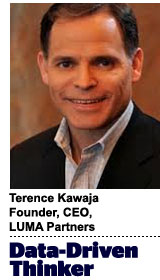 “Data-Driven Thinking” is a column written by members of the media community and containing fresh ideas on the digital revolution in media.
“Data-Driven Thinking” is a column written by members of the media community and containing fresh ideas on the digital revolution in media.
Terence Kawaja is Founder and CEO at LUMA Partners, a boutique investment bank focused on the digital media sectors.
In lieu of making the ubiquitous end of year Top 10 lists or predictions, here are some personal and industry resolutions for 2013:
Communicate more. Something I resolve to do more in 2013 is communicate more. You should too. Tell that customer how much you appreciate their business, discuss issues you are having with a vendor, chat with employees frequently on what is working and what isn’t. Invariably, communication helps identify, minimize and solve problems easier. I’ts also effective. I am a big fan of Gary Vaynerchuk, whose unconventional speaking style (and substance) have earned him a significant following. But in between speeches, Gary regularly communicates his thoughts on various social media outlets. I particularly like his short (and often impromptu) videos where he discusses a thought or concept. I hope to test this out myself in 2013.
Network like you mean it. I find many people at conferences chit chat at a leisurely pace and without much focus or objective. Remember that you’re working and your time is valuable. Identify with whom you want to meet/get to know better/discuss an issue and seek them out. You wont get to all names and some of the most valuable interactions will be serendipitous (especially at the bar). But go in with a plan – that will at least keep you from wasting a good opportunity.
Be self aware. If there is one quality in a startup CEO I appreciate most it is self awareness. No company has all the answers and the road to success is almost never a straight line. So when a CEO is always saying their company is “crushing it”, they lose credibility. This then calls in question all their other statements. My advice: be honest. People have a surprisingly good bullshit detector and building credibility is one of the most important assets. In dynamic times (see below), you may well need it.
Adapt. I believe the industry term is “pivot”, but like most acronyms and catch phrases, they lose or distort their meaning over time. In 2012, a good friend of mine who is a CEO of a young digital company, significantly changed his company’s position in the marketplace and is now thriving. His determination and industry leadership enabled this transformation which will likely result in a big win for investors. Of course, one must have both the appreciation for the dynamics which necessitate change and then the fortitude to act. I suspect that the need for adaptation will only increase as the dynamism of the industry accelerates. Stay on your toes!
Think big. As Jason Calacanis aptly points out, moderate success is the enemy of breakout success. This couldn’t have more applicability than to the digital advertising industry. Incremental solutions that marginally improve ROI/yield/distribution/whatever do not add value to the already-cluttered ecosystem. New enterprises should set their goals high and bring fundamental improvement/change to whatever sector they pursue. At the end of the day, true innovation gets rewarded, especially in strategic M&A.
Get some sleep. On a personal note, I have resolved to sleep more and earlier. Ever a night owl, I have gotten into the habit of working late – often well past midnight. Once my family goes to bed, those 3-5 hours can be very productive without an active inbox. But I am convinced it’s not worth it. My grandmother once told me “the hours before midnight count for double”. I think she’s right (and Arianna Huffington I guess) and I resolve to hit the sack earlier (wish me luck).
Follow Terence Kawaja (@tkawaja), LUMA Partners (@LUMA_partners) and AdExchanger (@adexchanger) on Twitter.












